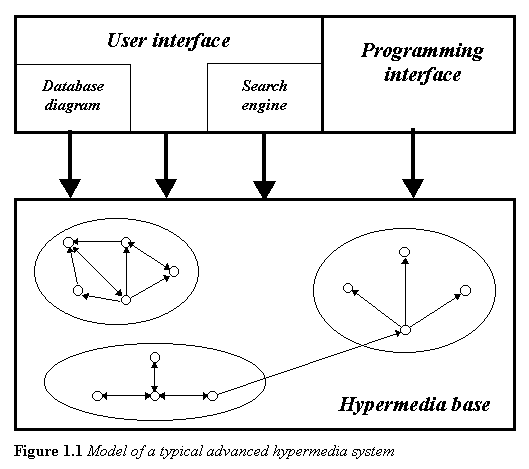
A user's access to information primarily occurs directly via the
hyperdocument nodes, by presenting each node in a screen window.
This is suggested in Figure 1 by that part of the user interface
box which goes directly to the hyperbase. The user will then follow
the links from node to node based on the information contained
in each node.
For a number of reasons it is not always sufficient to follow
links to access the desired information. For example, the user
may have "lost his way" and is unable to locate what
s/he wants in the hyperbase, or the structure in the document
may be too difficult to understand. Therefore two alternatives
exist for accessing information: using a database diagram, or
simply diagram, and using a search engine.

A database diagram is a graphic overview of the hyperdocument.
It allows the user to navigate directly between nodes in the hyperdocument,
without following the links. Furthermore, such diagrams may help
users navigate by allowing them to more easily understand the
structure of the document. They thus simplify both navigation
and orientation in the hypermedia database.
A search engine is a mechanism which allows a user to search directly
for information in the hypermedia database. Search engines may
find nodes of a certain type, or names or nodes containing specific
information. Search engines therefore will normally disregard
the existing hyperdocument structure.
Advanced hypermedia systems may have search engines which allow
the formulation of direct queries in the hyperbase. Users may
then describe precisely the information they want using a formal
language. Using a structured query language may also be applied
to filtering. The information found by the search engine may then
be merged with the structure information of the hyperdocument,
allowing the user to see only an excerpt of the hyperdocument.
This permits the user to navigate in the usual way, via links
and diagrams, but only accessing those parts of the hyperdocument
which satisfy the formulated query.
Some hypermedia systems have special programming interfaces enabling
the creation of special applications for the existing hypermedia
system. Furthermore, the programming interface may be used to
add new features to the system. It may for example be used to
connect the hypermedia database to more advanced search routines,
or to link it to other applications allowing these to access the
information in the hypermedia database.